Impact of Climate Change on Land Use, Yield and Production of Cassava in Thailand
Abstract
1. Introduction
2. Materials and Methods
2.1. Method
2.2. Data
3. Results and Discussion
3.1. Estimated Results
3.1.1. Factors Influencing the Harvested Area of Cassava
3.1.2. Factors Influencing Cassava Yield
3.2. Projected Impact of Climate Change on Harvested Area, Yield and Production of Cassava
4. Conclusions
Author Contributions
Funding
Conflicts of Interest
References
- Howeler, R.; Lutaladio, N.; Thomas, G. Save and Grow: Cassava. A Guide to Sustainable Production Intensification; FAO: Rome, Italy, 2013. [Google Scholar]
- Montagnac, J.A.; Davis, C.R.; Tanumihardjo, S.A. Nutritional value of cassava for use as a staple food and recent advances for improvement. Compr. Rev. Food Sci. Food Saf. 2009, 8, 181–194. [Google Scholar] [CrossRef]
- Marx, S. Cassava as feedstock for ethanol production: A global perspective. In Bioethanol Production from Food Crops; Academic Press: Cambridge, MA, USA, 2019; pp. 101–113. [Google Scholar]
- Falade, K.; Akingbala, J. Utilization of Cassava for Food. Food Rev. Int. 2011, 27, 51–83. [Google Scholar] [CrossRef]
- UN Comtrade. Cassava Export’s Statistics. Available online: https://comtrade.un.org/data (accessed on 10 July 2020).
- FAOSTAT. Food and Agriculture Organization of the United Nations, Statistics Division. Forestry Production and Trade. Available online: http://www.fao.org/faostat/en/#data/QC (accessed on 20 June 2020).
- Farmer ONE. Office of Agricultural Economics. Available online: http://farmerone.org/ (accessed on 20 July 2020).
- Pipitpukdee, S.; Attavanich, W.; Bejranonda, S. Climate Change Impacts on Sugarcane Production in Thailand. Atmosphere 2020, 11, 408. [Google Scholar] [CrossRef]
- Miao, R.; Khanna, M.; Huang, H. Responsiveness of Crop Yield and Acreage to Prices and Climate. Am. J. Agric. Econ. 2016, 98, 191–211. [Google Scholar] [CrossRef]
- Amin, M.R.; Zhang, J.; Yang, M. Effects of Climate Change on the Yield and Cropping Area of Major Food Crops: A Case of Bangladesh. Sustainability 2015, 7, 898–915. [Google Scholar] [CrossRef]
- Attavanich, W.; McCarl, B.A.; Ahmedov, Z.; Fuller, S.W.; Vedenov, D.V. Effects of climate change on US grain transport. Nat. Clim. Chang. 2013, 3, 638–643. [Google Scholar] [CrossRef]
- IPCC. 2013: Annex I: Atlas of Global and Regional Climate Projections. In Climate Change 2013: The Physical Science Basis. Contribution of Working Group I to the Fifth Assessment Report of the Intergovermental Panel on Climate Change; Cambridge University Press: Cambridge, UK; New York, NY, USA, 2013; pp. 1311–1393. [Google Scholar]
- Jarvis, A.; Ramirez-Villegas, J.; Herrera Campo, B.V.; Navarro-Racines, C. Is Cassava the Answer to African Climate Change Adaptation? Trop. Plant. Biol. 2012, 5, 9–29. [Google Scholar] [CrossRef]
- Tatsumi, K.; Yamashiki, Y.; Valmir da Silva, R.; Takara, K.; Matsuoka, Y.; Takahashi, K.; Maruyama, K.; Kawahara, N. Estimation of potential changes in cereals production under climate change scenarios. Hydrol. Process. 2011, 25, 2715–2725. [Google Scholar] [CrossRef]
- Adhikari, U.; Nejadhashemi, A.P.; Woznicki, S.A. Climate change and eastern Africa: A review of impact on major crops. Food Energy Secur. 2015, 4, 110–132. [Google Scholar] [CrossRef]
- Blanc, E. The Impact of Climate Change on Crop Yields in Sub-Saharan Africa. Am. J. Clim. Chang. 2012, 1, 13. [Google Scholar] [CrossRef]
- Isaiah, A.; Yamusa, A.; Odunze, A. Impact of Climate Change on Rainfall Distribution on Cassava Yield in Coastal and Upland Areas of Akwa Ibom State, Nigeria. J. Exp. Agric. Int. 2020, 42, 44–53. [Google Scholar]
- Adejuwon, J.; Agundiminegha, Y. Impact of climate variability on cassava yield in the humid forest agro-ecological zone of Nigeria. J. Appl. Sci. Environ. Manag. 2019, 23, 903–908. [Google Scholar] [CrossRef]
- Attavanich, W.; Schilling, B.J.; Sullivan, K.P. Measuring the effects of preservation on farm profits in a continuous treatment setting. Appl. Econ. 2016, 48, 5850–5865. [Google Scholar] [CrossRef]
- Wooldridge, J.M. Econometric Analysis of Cross Section and Panel Data; The MIT Press: Cambridge, MA, USA; London, UK, 2002. [Google Scholar]
- Anselin, L. Spatial Econometrics: Methods and Models; Springer Science & Business Media: Berlin/Heidelberg, Germany, 2013; Volume 4. [Google Scholar]
- White, H.A. Heteroskedasticity-consistent covariance matrix estimator and a direct test for heteroskedasticity. Econometrica 1980, 48, 817–838. [Google Scholar] [CrossRef]
- Office of Agricultural Economics. Available online: http://www.oae.go.th/view/1/มันสำปะหลัง/TH-TH (accessed on 10 June 2020).
- Royal Irrigation Department. Available online: http://www1.rid.go.th/main/index.php/th/2019-04-24-19-04-00/2019-04-24-19-05-44 (accessed on 10 June 2020).
- Ministry of Labour. Available online: https://www.mol.go.th/อัตราค่าจ้างขั้นต่ำ/ (accessed on 10 June 2020).
- National Oceanic and Atmospheric Administration. Cold & Warm Episodes by Season. Available online: https://origin.cpc.ncep.noaa.gov/products/analysis_monitoring/ensostuff/ONI_v5.php (accessed on 10 June 2020).
- Department of Provincial Administration Population Statistics. Available online: https://stat.bora.dopa.go.th/ (accessed on 10 June 2020).
- Office of the National Economic and Social Development Council. Hypothetical Study Report to Be Used to Estimate the Population of Thailand 2010–2040; NESDC: Bangkok, Thailand, 2019. Available online: https://www.nesdc.go.th/ewt_w3c/ewt_dl_link.php?nid=9812 (accessed on 20 June 2020).
- Orimoloye, I.; Adigun, A. Response of cassava and maize yield to varying spatial scales of rainfall and temperature scenarios in Port Harcourt. Res. J. Environ. Sci. 2017, 11, 137–142. [Google Scholar]
- Boansi, D. Effect of climatic and non-climatic factors on cassava yields in Togo: Agricultural policy implications. Climate 2017, 5, 28. [Google Scholar] [CrossRef]
- Ayanlade, A.; Odekunle, T.; Orinmogunje, O.; Adeoye, N. Inter-annual climate variability and crop yields anomalies in the middle belt of Nigeria. Adv. Nat. Appl. Sci. 2009, 3, 452–465. [Google Scholar]

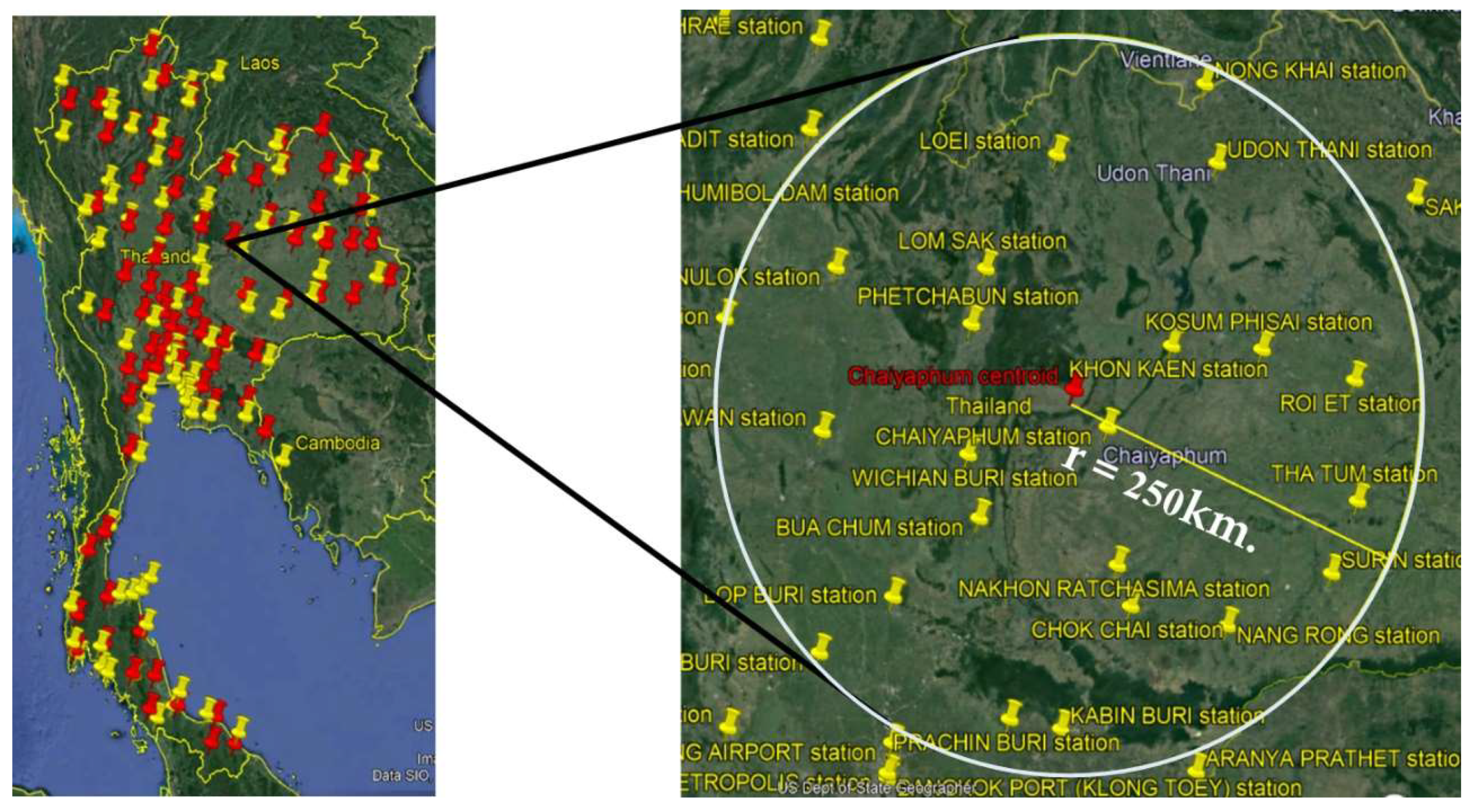
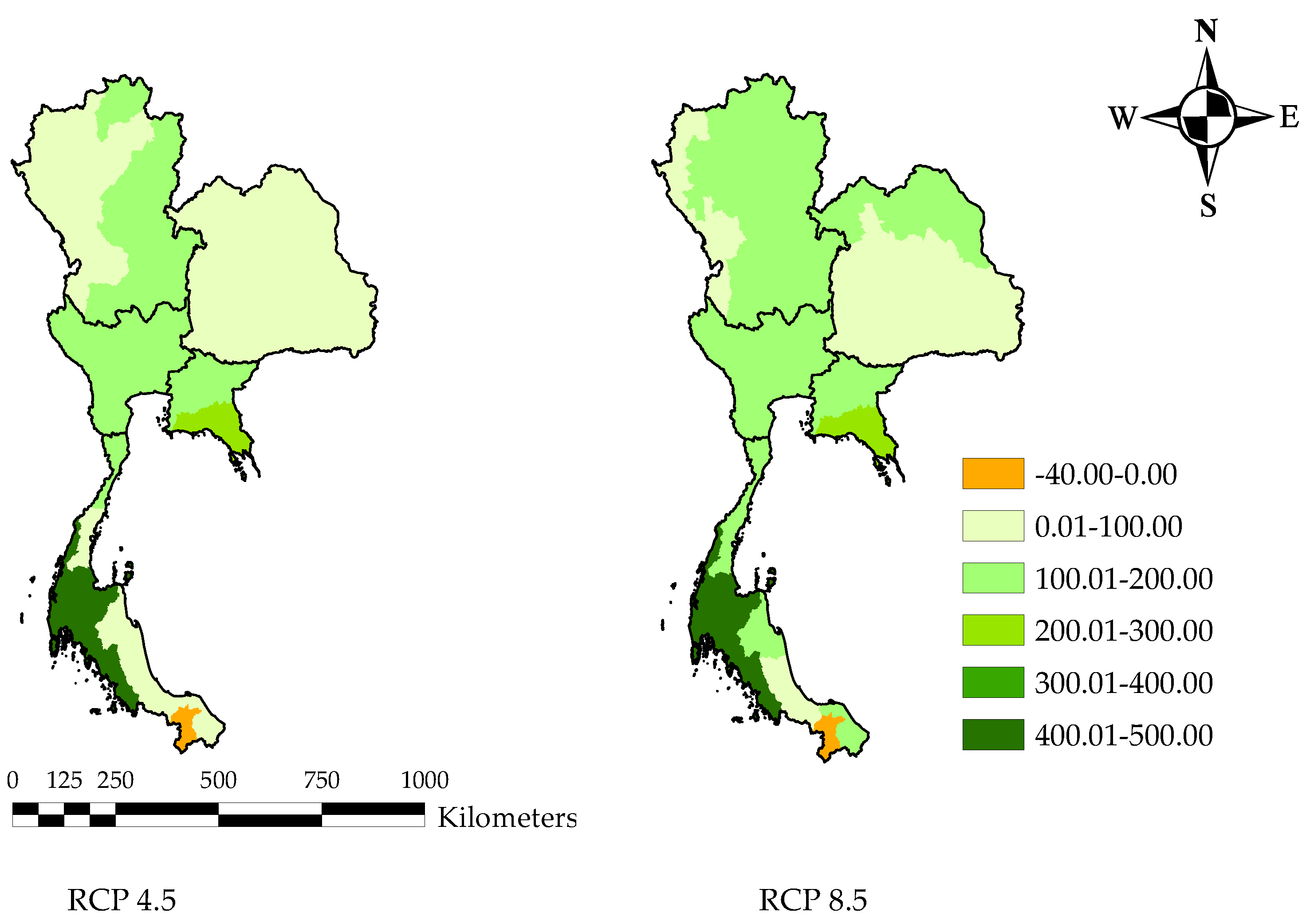
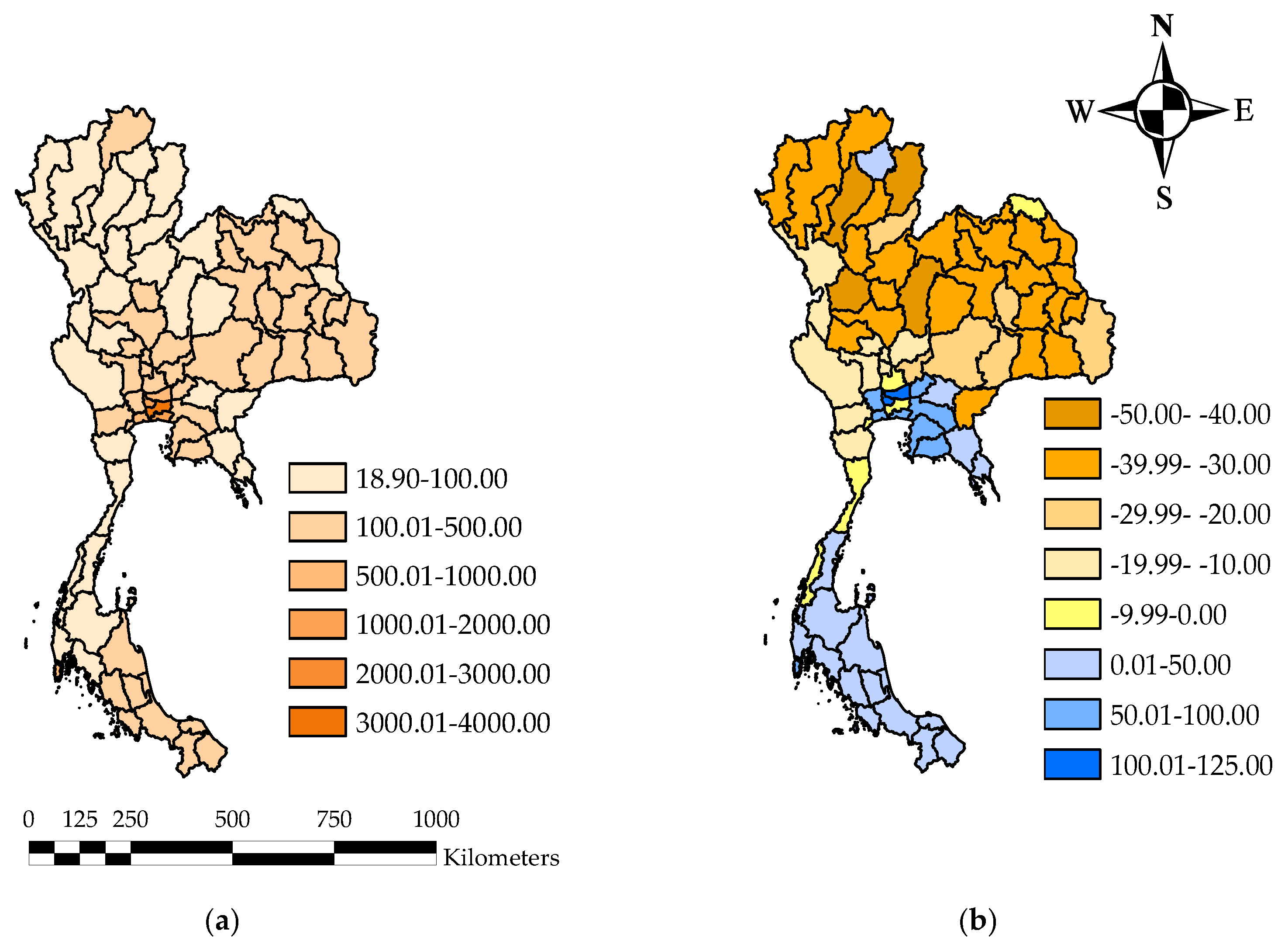

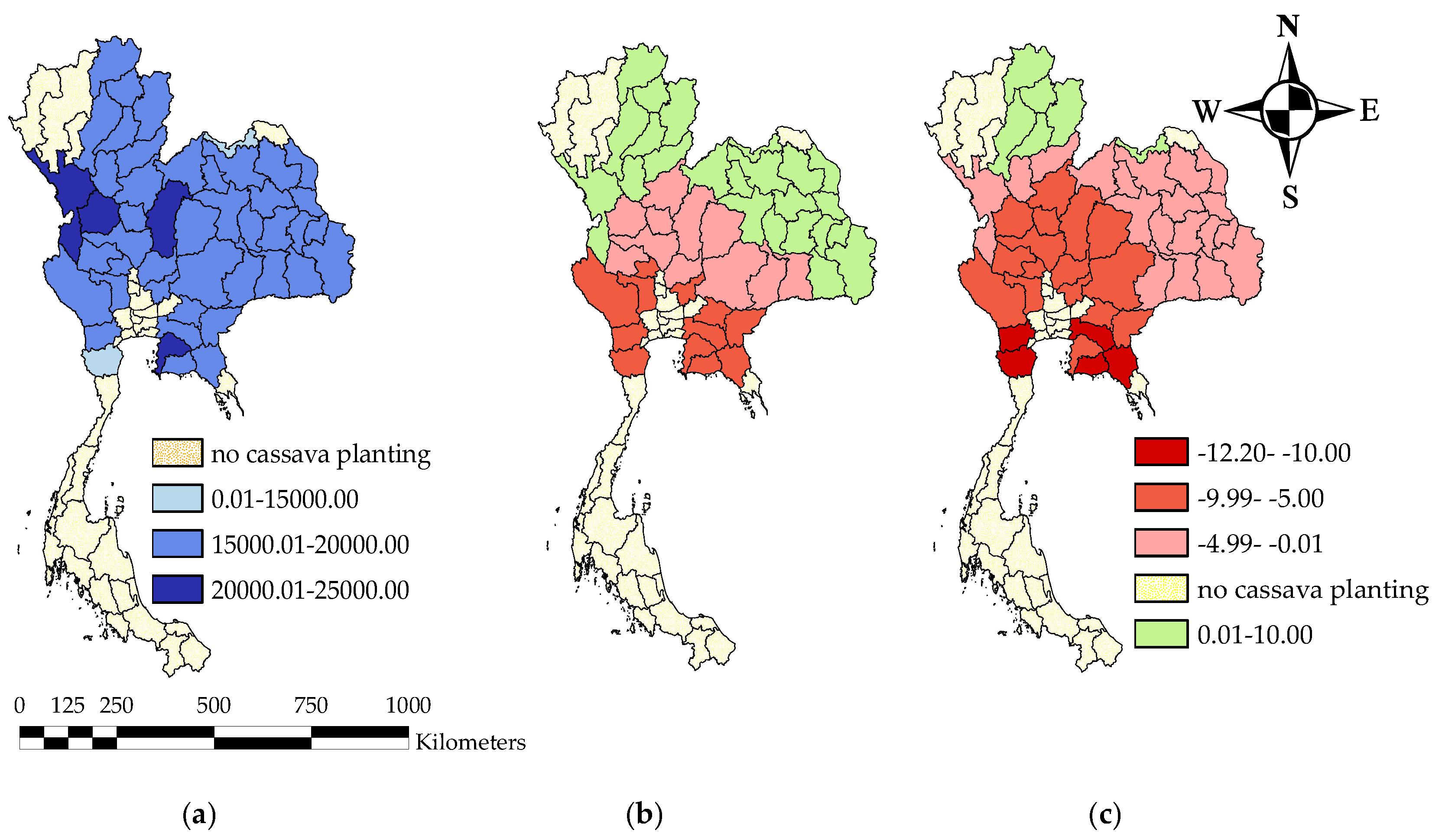
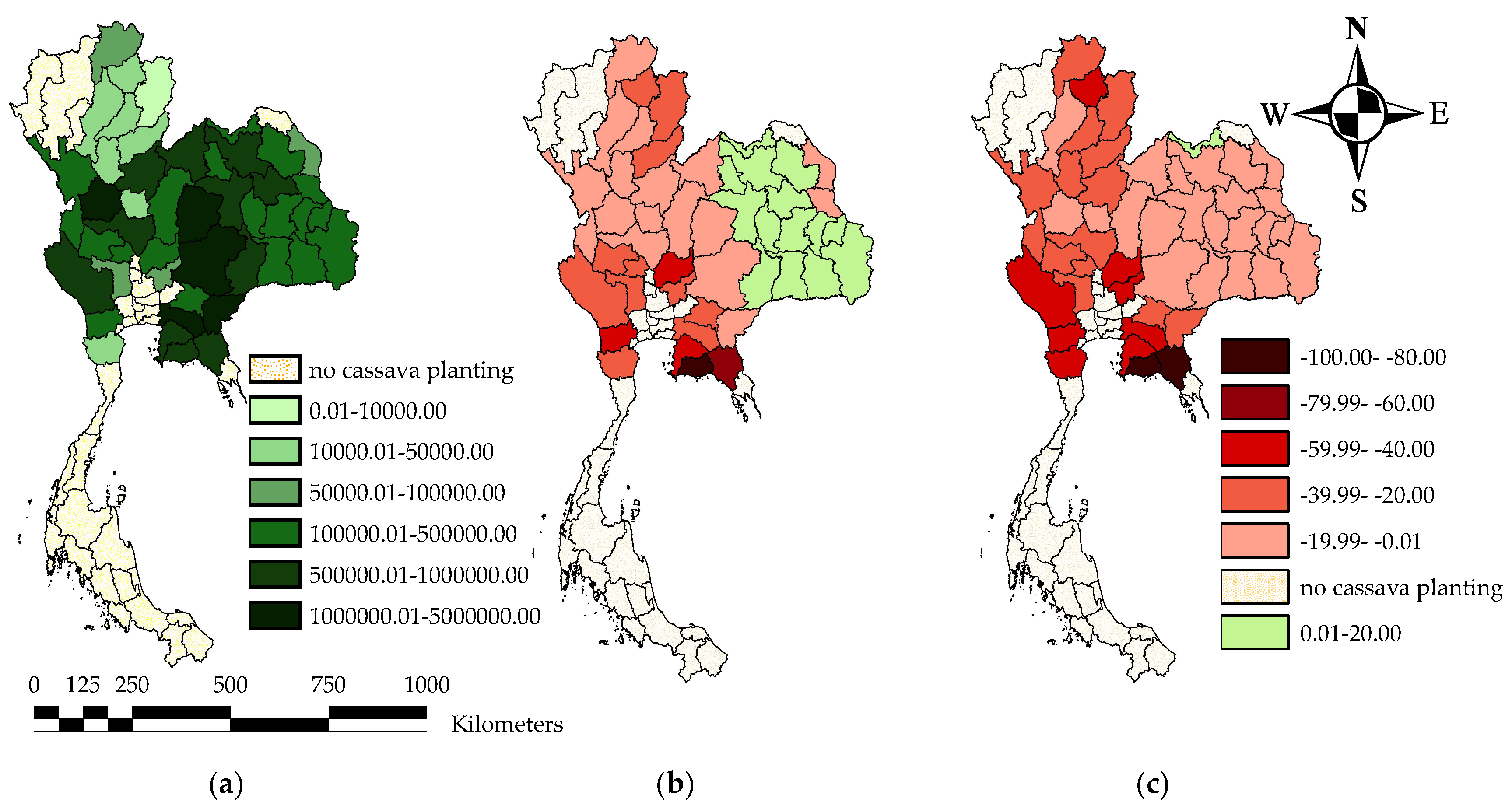
| Selected Variables | Mean | SD | Min | Max |
|---|---|---|---|---|
| Harvested area (1000 HA) | 26.74 | 41.42 | 0.04 | 317.40 |
| Yield (kg/HA) | 17,440.85 | 3445.39 | 10,443.75 | 27,550.00 |
| Average temperature (°C) | 27.46 | 0.72 | 25.03 | 29.09 |
| Maximum rainfall in 24 h (mm/day) | 33.87 | 4.00 | 22.98 | 47.28 |
| Extreme maximum temperature (°C) | 35.92 | 0.55 | 34.34 | 37.38 |
| Total rainfall (mm) | 1346.04 | 206.51 | 886.76 | 2007.98 |
| Population density (Person/sq.km) | 112.62 | 46.16 | 21.51 | 339.11 |
| Lag received price (USD/t) | 51.64 | 17.24 | 18.28 | 116.21 |
| Lag wage (USD) | 6.42 | 1.26 | 4.88 | 9.69 |
| % Irrigated area per province area | 7.82 | 10.95 | 0 | 60.68 |
| No. of observation | 1242 |
| Variables | Coefficients | Standard Errors |
|---|---|---|
| Time trend | −2.92 *** | 0.92 |
| Time trend square | 0.12 *** | 0.04 |
| Population density | −0.09 *** | 0.03 |
| % Irrigated area per province area | 0.25 ** | 0.12 |
| Total rain | 0.02 | 0.03 |
| Total rain square | −1.95 × 10−5 * | 1.10 × 10−5 |
| Maximum rain in 24 h | −0.44 | 0.43 |
| Extreme max temperature | −0.48 | 2.42 |
| El Niño | −3.80 | 2.54 |
| La Niña | 20.24 *** | 6.74 |
| North | 1.63 | 5.31 |
| Northeast | 42.57 *** | 5.5 |
| East | 33.35 *** | 6.11 |
| Lag price | −0.66 ** | 0.28 |
| Lag wage | 2.22 | 1.57 |
| Constant | 76.22 | 83.43 |
| Observations | 1242 | |
| R-square adjusted | 0.84 | |
| Root MSE | 10.58 |
| Variables | Coefficients | Standard Errors |
|---|---|---|
| Time trend | 82.29 | 100.08 |
| Time trend square | 13.63 *** | 4.68 |
| % Irrigated area per province area | −21.85 *** | 7.18 |
| Average temperature | 18,965.98 *** | 4.95 × 103 |
| Average temperature square | −365.73 *** | 91.03 |
| Total rain | −6.47 *** | 2.29 |
| Total rain square | 5.79 × 10−4 | 7.79 × 10−4 |
| Maximum rain in 24 h | 78.03 *** | 27.22 |
| Extreme max temperature | 1438.41 *** | 270.30 |
| El Niño | −1495.48 *** | 209.04 |
| La Niña | 1198.04 ** | 585.61 |
| North | −2259.85 *** | 403.96 |
| Northeast | −1640.49 *** | 344.84 |
| East | 3210.47 *** | 379.92 |
| Lag price | −59.16 ** | 27.69 |
| Lag wage | −617.81 *** | 75.68 |
| Constant | −2.71 × 105 *** | 68,636.46 |
| Observations | 1242 | |
| R-square adjusted | 0.75 | |
| Root mean square error (MSE) | 1487.28 |
| Projected Changes in Growing Season Temperature (°C) | Projected Changes in Average Annual Extreme Maximum Temperature (°C) | Projected Changes in Annual Maximum Precipitation Within 24 h (mm) | ||||
|---|---|---|---|---|---|---|
| RCP 4.5 | RCP 8.5 | RCP 4.5 | RCP 8.5 | RCP 4.5 | RCP 8.5 | |
| Central | 1.08 | 1.48 | 1.21 | 1.61 | 0.07 | 0.12 |
| North | 1.22 | 1.65 | 1.52 | 1.80 | 0.06 | 0.19 |
| Northeast | 1.22 | 1.68 | 1.55 | 1.86 | 0.04 | 0.11 |
| East | 1.08 | 1.48 | 1.21 | 1.61 | 0.07 | 0.12 |
| Variables | Baseline | Percent of Change under RCP 4.5 | Percent of Change under RCP 8.5 |
|---|---|---|---|
| Harvested area | 1212 (1000 ha) | −12.49 | −16.05 |
| Yield | 18,400 (kg/ha) | −2.57 | −6.22 |
| Production | 22.32 (1000 MT) | −14.74 | −21.26 |
© 2020 by the authors. Licensee MDPI, Basel, Switzerland. This article is an open access article distributed under the terms and conditions of the Creative Commons Attribution (CC BY) license (http://creativecommons.org/licenses/by/4.0/).
Share and Cite
Pipitpukdee, S.; Attavanich, W.; Bejranonda, S. Impact of Climate Change on Land Use, Yield and Production of Cassava in Thailand. Agriculture 2020, 10, 402. https://doi.org/10.3390/agriculture10090402
Pipitpukdee S, Attavanich W, Bejranonda S. Impact of Climate Change on Land Use, Yield and Production of Cassava in Thailand. Agriculture. 2020; 10(9):402. https://doi.org/10.3390/agriculture10090402
Chicago/Turabian StylePipitpukdee, Siwabhorn, Witsanu Attavanich, and Somskaow Bejranonda. 2020. "Impact of Climate Change on Land Use, Yield and Production of Cassava in Thailand" Agriculture 10, no. 9: 402. https://doi.org/10.3390/agriculture10090402
APA StylePipitpukdee, S., Attavanich, W., & Bejranonda, S. (2020). Impact of Climate Change on Land Use, Yield and Production of Cassava in Thailand. Agriculture, 10(9), 402. https://doi.org/10.3390/agriculture10090402




